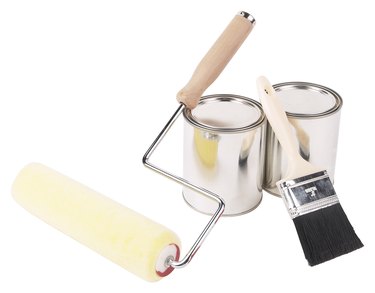
A fresh coat of paint can add to your home's resale value, liven up a dull room or change the entire look of the home's exterior. Any reasonably crafty homeowner can learn to paint both interior and exterior surfaces. If the texture is rough, the job is a bit more challenging.
Rollers and Roller Covers
Video of the Day
On smooth walls, virtually any paint roller cover will do. If the surface is textured, choose a tough lamb's wool roller cover. On textured interior walls and smooth concrete block, the ideal nap length is three-fourths of an inch. For stucco and extremely rough plaster or concrete block, choose a nap that is at least one inch. Better roller covers have plastic rather than cardboard cores.
Video of the Day
Avoid thin plastic roller frames, which may bend or break when used on rough surfaces. Choose a sturdy metal roller that is reasonably heavy. Test the roller in your hand before purchasing it to ensure that the grip is comfortable. Some heavy-duty roller frames are uncomfortable for painters with small hands.
Paintbrushes
Low-cost paintbrushes tend to shed fibers, collect paint clumps and even bend or break under pressure. Look for professional-grade brushes with wood or hard plastic handles. Choose synthetic bristles in a poly-nylon blend if you are using latex paint. Use stiff natural bristles when applying oil-based paint.
You will need a variety of paintbrush sizes to cover all of the nooks and crannies in rough walls. Choose a selection of brushes ranging from one to three inches in size.
Masking
Runs and drips are always possible during any painting project. When painting rough walls, the chances for drips and spills are much higher, since paint drops may accumulate on the surface. Thoroughly cover all areas that will not be painted, including windows and floors. Remove all hardware from the walls. Carefully line the edges of windows and other unpainted surfaces with painter's tape.
Cutting In
Cutting in is the process of brush-painting areas that a paint roller will not reach. Dip the brush into the paint can and wipe off the excess along the edge of the can. It is tempting to apply a thick layer of paint onto rough surfaces, but doing so greatly increases the chance of runs or drips. Instead, use a moderate amount of paint on each pass. Wiggle the brush back and forth and up and down to force paint into the textured surface. Use wide brushes whenever possible, choosing narrow brushes only for detail work.
Rolling
Dip the paint roller into the paint and roll it out in a paint tray or bucket screen. Use wide "W" strokes to apply the paint to the wall. You will need to roll over each section several times to force paint into the lower points of the textured wall. Begin at the top of the wall and work down, rolling out any drips as you go along.
Multiple Coats
Rough walls generally require at least two coats of paint for even coverage. If you choose a bold color such as red, plan to paint at least three coats. Allow the wall to dry overnight between coats. Inspect it each morning in strong light to check for thin spots.